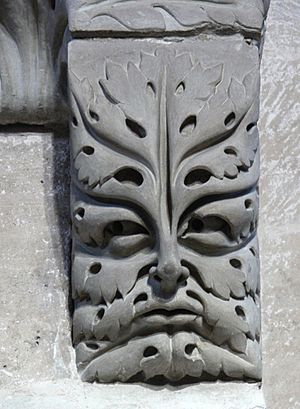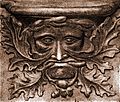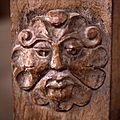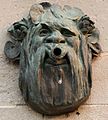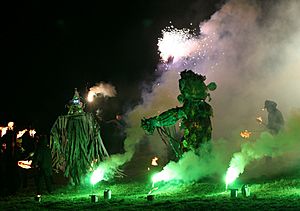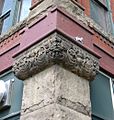Green Man facts for kids
The Green Man is a legendary figure. People see him as a symbol of new beginnings. He represents the cycle of growth that happens every spring. The Green Man is usually shown as a face made of leaves. Sometimes, he is completely surrounded by them.
This Green Man design has many different looks. Branches or vines might grow from his mouth, nose, or other parts of his face. These plants can even have flowers or fruit. You can find the Green Man in many cultures and times around the world. He is often linked to gods of nature and plants. Green Men are often used as decorations on buildings. You can see them carved on both regular buildings and churches. "The Green Man" is also a popular name for pubs in England. Their signs sometimes show a full person, not just a face.
Some people think the idea of the Green Man grew up on its own in different old cultures. They believe it then changed into the many examples we see throughout history.
Contents
Types of Green Man Faces
In architecture, these carvings are often called foliate heads or leafy masks. Green Man carvings can look very natural or be more decorative. The simplest ones show a man's face looking out from thick leaves. Some might have leaves for hair or a leafy beard. Often, leaves or plant shoots grow from his open mouth. Sometimes they even grow from his nose and eyes. In the most artistic examples, the carving might look like just leaves at first. You only see the face when you look very closely. The face is almost always male. Green women are very rare.
Lady Raglan was the first to use the name "Green Man" for these carvings. She wrote about them in her 1939 article The Green Man in Church Architecture. Her interest came from carvings at St. Jerome's Church in Llangwm, Monmouthshire.
The Green Man appears in many forms. The three most common types are:
- The Foliate Head: This type is completely covered in green leaves.
- The Disgorging Head: This one spits out plants from its mouth.
- The Bloodsucker Head: This type has plants growing from all its face openings. This includes tear ducts, nostrils, mouth, and ears.
History of the Green Man
Mike Harding wrote a book called A Little Book of The Green Man. In it, he shares examples of Green Man figures from Lebanon and Iraq. These date back to the 2nd century. Similar figures can be found in Borneo, Nepal, and India.
An example from the late 4th century shows a Green Man spitting out plants. It is found at St. Abre, in St. Hilaire-le-grand, France.
The tradition of carving the Green Man on Christian churches is found all over Europe. For example, there are Seven Green Men of Nicosia. They are carved on the outside of the 13th-century St Nicholas Church in Cyprus.
Harding also mentions a leafy head from an 8th-century Jain temple in Rajasthan.
There are Romanesque leafy heads in 11th-century Templar churches in Jerusalem. Harding thinks the symbol might have started in Asia Minor. He believes traveling stone carvers brought it to Europe.
After the Renaissance, many new Green Man designs appeared. These often had animal heads instead of human faces. They were used in many art forms, not just carvings. This included old books, metalwork, bookplates, and stained glass. These later designs seemed to be just for decoration. They probably did not show any deep beliefs. A Swiss engraver named Numa Guyot made a very detailed bookplate of a Green Man around 1887.
In Britain, the Green Man became popular again in the 19th century. Architects liked him during the Gothic revival and the Arts and Crafts era. He appeared as a decoration on many buildings, both religious and everyday ones. American architects also started using the design around the same time. Many different versions can be seen in Neo-gothic Victorian buildings. He was very popular with Australian stonemasons. You can find him on many buildings there, including one on Broadway, Sydney.
Green Man in Churches
The Green Man might seem like a pagan symbol. He looks like a nature spirit or a god of fertility. He is similar to the woodwose, a wild man of the woods. Yet, he often appears carved in wood or stone inside churches. You can find examples dating up to the 20th century.
Characters Similar to the Green Man
The ancient Egyptian god Osiris is sometimes seen as a grain god. He is often shown with a green face. This green color represents plants, rebirth, and coming back to life. In some old tombs, people found containers shaped like Osiris. These were filled with soil and planted with seeds. The sprouting grain showed that the dead person would be reborn.
Other gods shown in green include Amogha-siddhi in Tibet and Tlaloc in Mexico.
People have compared the Green Man to many different gods. These include the British Celtic god Lud, Osiris, Odin, Dionysus, and even Jesus. Father Christmas, who was often shown with ivy in old pictures, has also been suggested as a similar forest spirit.
In countries like Germany, Iceland, and England, Green Man pictures might have been inspired by gods like Freyr or Odin. Both of these gods share many traits with the later Green Men found across Europe.
Another idea for the Green Man's head is that it comes from Norse Mythology. It could be Mímir’s head. Mímir is Odin's uncle and a god of knowledge and wisdom. He was beheaded in a war. His head was then sent to Odin. Odin preserved it with herbs so Mímir’s wisdom would not be lost. After the Viking Age in the UK, some churches used the Green Man design to represent knowledge and wisdom.
A character similar to the Green Man appears in the Mildenhall Treasure. This is a silver dish from the 4th century found in England. The dish shows a leafy mask surrounded by party figures. This mask is thought to be Neptune or Oceanus, and the leaves are seaweed.
Some people connect the Green Man with "Jack in the Green." Green cats, lions, and demons are also found. On gravestones, human skulls are sometimes shown with grapevines or other plants growing from them. This likely symbolizes coming back to life.
In Sanskrit, the Green Man is similar to the gana Kirtimukha, or "Face Of Glory." This is linked to a story about Shiva. The Face of Glory is often seen in Buddhist art. It is often shown crowning the 'Wheel of Becoming.'
Khidr, also called al-Khidr, means "the Green One" in Arabic. He is a respected figure in Islam. The Qur'an describes him as a good servant of God who had great wisdom. In the Qur'an, al-Khidr was said to be wiser than Moses.
In Sufism, a part of Islam, Khidr is seen as the Green Man. Tom Cheetham, an expert on Islamic mysticism, talks about Khidr as a link between the spirit world and the physical world. William Anderson, who writes about spirituality, says about al-Khidr: "There are stories where he is reborn, like Osiris. He is also linked to the end of time, like the Green Man. His name means the Green One. He inspires artists. He can appear as a white light or a gleam on grass. But more often, he comes as an inner feeling. When he is present, you can work with endless energy, beyond your usual limits."
The Green Man in Popular Culture
Literature
The Green Man is a common idea in books. Sometimes, characters like Robin Hood and Peter Pan are linked to the Green Man. The Green Knight in the poem Sir Gawain and the Green Knight is also connected. The Green Knight acts as both a challenge and a teacher to Sir Gawain. He comes from an old, non-Christian world. This world seems against the Christian one, but in the end, they live together. After World War II, scholars thought the Green Knight was a literary version of Lady Raglan's Green Man. This idea helped people believe the Green Man was a real medieval folk figure.
Sir James Frazer mentions the tradition in his book The Golden Bough. Kingsley Amis's novel The Green Man (1969) is about a modern Green Man. In the book, he is an ancient pagan monster. Stephen Fry wrote a funny poem called "The Green Man" in his novel The Hippopotamus. Charles Olson and Ronald Johnson also wrote poems about the Green Man. The idea has even appeared in comics, like with the character Swamp Thing.
In Thomas Nashe's play Summer's Last Will and Testament (1592), a character says, "The rest of the green men have reasonable voices..."
Green men often appear in modern fantasy and science fiction. Tom Bombadil and the Ents in The Lord of the Rings could be examples. In Kenneth Grahame's children's book The Wind in the Willows (1908), a nature god appears. He is like Pan and the Green Man. This is a key moment in the chapter "The Piper at the Gates of Dawn." (The band Pink Floyd later named their first album after this chapter.) Robert Jordan's series The Wheel of Time has a character named Someshta, called "the Green Man." He is the last of a race called the Nym. They were the world's gardeners and could control plant growth.
The Cornish poet Charles Causley wrote a poem called Green Man In The Garden.
In the late 1990s and early 2000s, the Green Man appeared more often in children's books. Examples include Bel Mooney's The Green Man (1997) and Joining the Rainbow. Also, Jane Gardam's The Green Man (1998) and Geraldine McCaughrean's The Stones are Hatching (1998). In many of these stories, the Green Man takes on the roles of other wild men and gods. Especially those linked to seasonal death and rebirth. The Rotherweird Trilogy by Andrew Caldecott uses the Green Man idea a lot. The character Hayman Salt becomes the Green Man in the first book. The Deptford Mice books by Robin Jarvis feature a kind Green Mouse god. He is a mouse version of the Green Man.
The Green Man is a main character in Max Porter's novel Lanny. It was nominated for the Booker Prize in 2019. Green Men also play a big part in K. J. Charles's novel The Spectred Isle (2017).
The Green Man is one of the main characters in The Midnight Guardians by Ross Montgomery. He is getting his strength back to defeat the Midwinter King. He is shown to be able to bring spirits back to life.
In the Mercy Thompson series by Patricia Briggs, the character Uncle Mike is called Green Man. This is by the Welsh character Samuel Cornick in book 3.
Sculpture
The Green Man image has become popular again in modern times. Artists from all over the world use the image in their work. English artist Paul Sivell carved the Whitefield Green Man from a dead part of a living oak tree. David Eveleigh, an English garden designer, made the Penpont Green Man Millennium Maze in Wales. As of 2006, this was the largest Green Man image in the world. Zambian sculptor Toin Adams created a 12-meter-tall Green Man in Birmingham, UK. As of 2006, it was the largest standing Green Man sculpture in the world. Sculptor M. J. Anderson made a marble sculpture called Green Man as Original Coastal Aboriginal Man of All Time.
Other artists include Jane Brideson, Marjorie Bussey (Australia), Monica Richards (America), and Peter Pracownik (England). Pracownik's fantasy art has appeared in many forms, including full-body tattoos.
American artist Rob Juszak made the Green Man into Earth's spiritual protector. He showed the Green Man holding the planet. Dorothy Bowen painted a kimono silk painting called Greenwoman. This showed the female side of the legend.
Music
The band Jethro Tull performed the song Jack-in-the-Green on their 1977 album Songs from the Wood. "The Green Man" was a song by the English band Shut Up and Dance. It entered the UK charts in 1992. The band XTC has a song called "Greenman" on their album Apple Venus Volume 1. The lyrics include "See the Greenman blow his kiss from high church wall." A song called "Green Man" is on the American heavy metal band Type O Negative's album October Rust. The Green Man is the subject of Roy Harper's song "The Green Man." It is the first song on his album of the same name. The song "Diadem" on Waterson–Carthy's 2006 album Holy Heathens and the Old Green Man suggests the figure being praised is a Green Man.
Theatre and Festivals
The Green Man is part of performances like the Imbolc festival in Marsden, West Yorkshire. He is also featured at the Green Man Festival in Brecon Beacons, Wales.
Film and Television
The Green Man appears in several films. These include the first episode of The Canterbury Tales (1972) and The Draughtsman's Contract (1982). In the 1973 horror film The Wicker Man, the local pub is called 'The Green Man'. It is where a group of pagan islanders gather. The 2012 Disney film The Odd Life of Timothy Green seems to show a Green Man. The main character is a magical child who appears in a garden. He has leaves on his legs, gets energy from sunlight, and returns to the earth in the fall.
The Green Man has been shown in the Netflix series The Chilling Adventures of Sabrina. He is an old pagan god who wants to end humanity.
The 1990 BBC series The Green Man is based on Kingsley Amis's novel. Albert Finney starred as a modern Green Man.
"Your Green Man" is the title of an episode in the second season of Hellier (2019). This documentary series follows a paranormal investigator. He finds a large Green Man symbol carved into a tree. The Green Man mythology is explored in other episodes of the series.
The Green Man is part of the inspiration for Alex Garland’s 2022 horror film Men. He appears as a character in the movie.
Modern Paganism
For many modern pagans, the Green Man is a symbol of new seasons and caring for nature.
In Wicca, the Green Man is often used to represent the Horned God. This god combines parts of different deities, like the Celtic Cernunnos and the Greek Pan.
Images for kids
See also
 In Spanish: Hombre verde para niños
In Spanish: Hombre verde para niños
- Apple Tree Man
- Blodeuwedd
- Burryman
- Clun Green Man Festival
- Ent
- Flower Pot Men
- Gargoyle
- Green Giant
- The Green Man of Knowledge
- Grotesque
- Holly King and Oak King
- Hunky punk
- Jack in the Green
- Krampus
- Sheela na Gig
- Three hares
- Wild Man


